The Two Faces of Dr. Jekyll (1960)
Directed by: Terence Fisher
Written by: Robert Louis Stevenson, Wolf Mankowitz
Starring: Christopher Lee, David Kossoff, Dawn Addams, Paul Massie
UK
AKA HOUSE OF FRIGHT, JEKYLL’S INFERNO
AVAILABLE ON REGION ‘1’ DVD
RUNNING TIME: 88 min/ 83 min
REVIEWED BY: Dr Lenera, Official HCF Critic
Dr. Henry Jekyll is a dull, bookish scientist who spends more time with his laboratory animals testing theories of alternate personalities than with his beautiful, young wife Kitty, who has given up trying to find any passion in her distant, preoccupied husband and is involved in an affair with one of Jekyll’s old ‘friends,’ Paul Allen, a weak slacker and wastrel who relies on Jekyll to pay his numerous gambling debts. After experimenting on himself, Jekyll transforms himself into the young, dynamic, and self-confident Edward Hyde. In his new character he befriends Allen, who has no idea that this clean-cut, handsome playboy prone to outbursts of violence is really Jekyll. As Hyde, he encourages Allen to introduce him to the dark underbelly of London’s night life and begins an affair with Maria, an exotic dancer and snake charmer….
I’ve always found it a pity that Hammer never made a ‘straight’ adaption of Robert Louis Stevenson’s oft-filmed novella The Strange Case Of Dr Jekyll And Mr Hyde, though they did make three variations on it. The Ugly Duckling actually came out one year before this one, and was a comedic adaptation starring Bernard Bresslaw as a pharmacist who discovers a formula which transforms him from the bungling, buffoonish Jekyll into the smooth and dashing Teddy Hyde. This film appears to be lost, though it seems that it may have influenced Jerry Lewis’ classic comedy variant The Nutty Professor. Anyway, on to this second Hammer go at the story, and I don’t remember being too impressed by my first viewing of it a few years ago, but revisiting it revealed it to be, if not quite one of Hammer’s classics nor up there with the superb 1931 version [still the best] of this tale that starred Fedric March, a rather intriguing version of the story which is a little lacking in suspense and actual horror [in fact I don’t think a single drop of blood is spilt] but is surprisingly sophisticated to a point where it’s easy to see why 1960 horror movie going audiences didn’t flock to it, while many viewers of a more high brow nature wouldn’t have been seen dead going to a Hammer film. Seen today though, its adult approach and persuasive amorality help make it hold up quite well.
It was author and playwright Wolf Mankowitz who was chosen to script this film, which was initially untitled. He wrote it with Laurence Harvey, who had starred in the movie adaptation of his musical Expresso Bongo, in mind, and Harvey was keen to do it but was talked out of it by his agent. The dual lead role instead went to up-and-coming Canadian actor Paul Massie, to the great disappointment of Christopher Lee, though Lee did play the supporting part of Paul Allen and later played Jekyll and Hyde in all but name in I, Monster. Director Terence Fisher rewrote the script to steer it a bit closer to previous versions of the story while, as with The Brides Of Dracula, whole scenes, including a climax of Hyde transforming into Jekyll on the gallows, were lost because the release date was almost missed, though the production still overran and was completed at Elstree studios. Double billed in the UK with the French sex comedy Queen Mare’s Nest, it lost some sexual footage from Maria’s dance with a snake and her bedroom scene with Hyde, and shots of a strangulation, due to the BBFC, though these cuts were restored for DVD. In the US, Columbia considered the film too salacious and offloaded it to a subsidiary company Kingsley, who then sold it to American International Pictures who retitled it as House Of Fear and, occasionally, Jekyll’s Inferno, and cut five minutes from it, reducing the sexual material further and softening the language, words like “bitch”, “whore” and even “hell” , such offensive words obviously considered unsuitable for AIP’s usual drive-in audience. The film was a flop though in most countries, and became one of Hammer’s rarer horror pictures.
As usual, Jekyll believes that humans are comprised of two parts, parts which he says are beyond good and evil, though the script seems to spend most of the time contradicting that statement, even in the beginning scene where a young girl [Dracula’s Janine Faye again] is tormented by some bullies; a sign of the rewriting by Fisher, always interested in the idea of good and evil I suppose. Not that Jekyll is entirely sympathetic; he’s quite cold and harsh to others, and ignores his wife Kitty almost entirely except for the times when he ‘wants’ her, which are usually turned down. Hyde is a smooth handsome player who, on the surface of it, is more appealing than Jekyll, the film saying that evil need not be ugly. Because of this, we don’t get to see any grotesque makeup – in fact, we don’t even get to see a transformation scene, the nearest the film gets to one being when either Jekyll or Hyde speak in the other person’s voice – while one has to wonder if Kitty has ever seen her husband unshaven! One interesting twist sees Jekyll age some years every time he’s become Hyde, rather than Hyde looking progressively monstrous which is what you often have. Jekyll, after we’ve seen him inject a monkey [like in I, Monster, the drug is in the form of a needle rather than a drink], tries the potion on himself very early in the film. It’s not long before Hyde, as in the 1921, 1931 and 1941 versions, finds himself a girl whom he treats badly, but it seems to be the wife of his other self whom he’s really after, though she’s in love with Paul Allen, a wastrel who stoops so low as to ask for money from his mistress.
Much of the film takes place in The Phoenix, a London hotspot, an excuse for lots of reasonable-if-technically-nothing-special dance numbers, the most notable being Kitty’s amazingly risqué performance with a snake which ends with her putting it in her mouth. We also briefly visit some pubs and an opium den which was daring for 1960; then again, the whole film is daring for its blatant sexuality [showing the hypocrisy of Victorian society of course, the rich folk actually being more deviant than the poor people] and mature themes which recall The Portrait Of Dorian Gray, and which climax in Hyde raping Jekyll’s – or rather his own – wife in a tastefully handled but still quite shocking moment. Even the prostitution is surprisingly blatant in a film which, while as I’ve said before isn’t nearly as good a film overall, does stand with the 1931 version in really getting into the sexual side of things. It’s also interesting to a fan of this story to see a scene near the end which is a variant on one in the 1941 version which was cut out of most prints but apparently does exist in a few, where Jekyll talks to Hyde, who takes the form of a reflection in a mirror. By now the film has found itself some pace, though overall it does lack mounting tension, and Fisher is almost too restrained in not even showing a death by snake. Fisher once said that he regretted the way The Two Faces Of Dr Jekyll came out because none of the main characters are sympathetic, and, aside from Hyde’s girlfriend Maria this is, by and large, true. However, the final scene of the film does seem to tell us that good can always ‘break through’ to conquer evil [an obvious Fisher addition].
Bernard Robinson’s sets are typically lush, often with nicely worked out colour schemes [i.e. an all-white room with red curtains], though a couple of sadly unconvincing ones near the end let the side down somewhat. The Two Faces Of Dr Jekyll was sadly the last Hammer horror that Jack Asher photographed [he would be re-hired for the non-chillers The Secret Of Blood Island and The Brigand Of Kandihar]. He was taking too long with his meticulous set-ups for the Hammer heads and was therefore considered uneconomical. This meant that Hammer’s films, while still often very good [my favourite Hammer film of all time is still to come, for a start!] thereafter lacked much of the wonderful look that Asher helped give them. Though there’s a lovely moment early on where Kitty steps into a room from outside, both her dress and what we see of outdoors being a light blue, while the main dance area of The Sphinx is bathed in Asher’s favourite green, The Two Faces Of Dr Jekyll generally holds back on overly-stylised visuals until the final quarter where Asher really goes to town, perhaps already knowing that this would be his last Hammer horror. Maria being bathed in red as she goes to change is straight out of Mario Bava or early Dario Argento, but best of all is a simply gorgeous shot of Kitty lying on her bed composed of many different shades of pink.
Paul Massie is good though not great in the two main roles, slightly overplaying Hyde [at least as he’s depicted in this version] for my liking, though he’s hampered in his scenes as Jekyll by the artificial lowering of his voice. He does do well in the scenes where the two personalities are struggling for dominance though, even if some of his face-pulling is somewhat amusing. Christopher Lee, looser, less rigid than normal, has one of his most memorable Hammer supporting roles as Allen, helping to make the lazy, amoral spendthrift into someone oddly likable and sympathetic despite his many flaws, and really showing his versatility. Dawn Addams does the same with Kitty, though Norma Marla, who oddly enough had just been in The Ugly Duckling, was obviously cast as Maria chiefly for her looks. Francis De Wolff again plays a cop towards the end, and Oliver Reed makes a memorable debut appearance for Hammer as a man who starts a fight with Hyde. Monty Norman, best known for writing/partially writing [to which degree has been a source of great debate over the years] the James Bond theme, provides a nice score with a decent tragic main theme and some flavourful dance numbers, though playing two of them during the main titles seems inappropriately jaunty. Just missing the mark as one of Hammer’s greats, The Two Faces Of Dr Jekyll still has a lot to recommend it and is thoroughly enjoyable from beginning to end as long as you don’t expect the usual blood and thunder. It reminds us very pointedly that it’s what’s on the inside that makes a man either good or bad, as well as being the last example in Hammer Horror of the greatness that was Jack Asher, a true genius of a cinematographer.

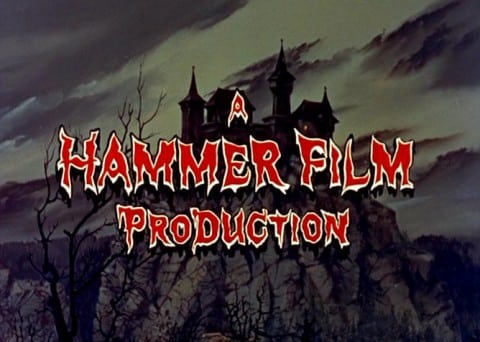
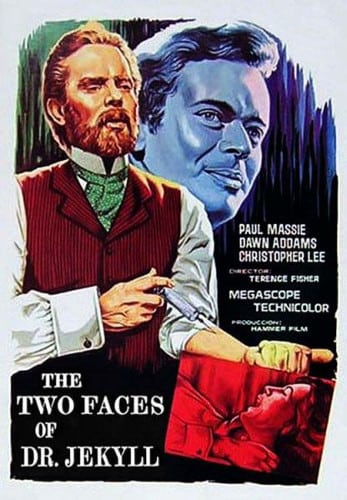
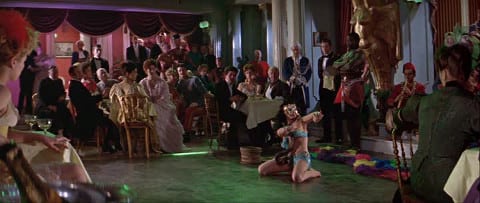






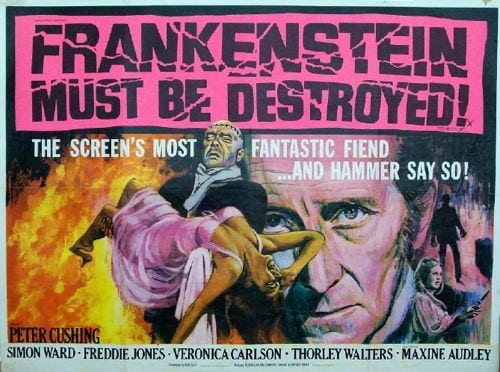
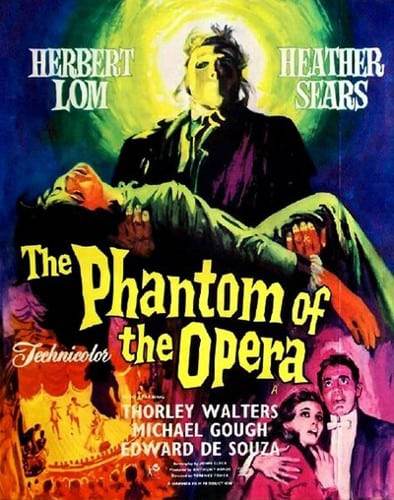
Be the first to comment